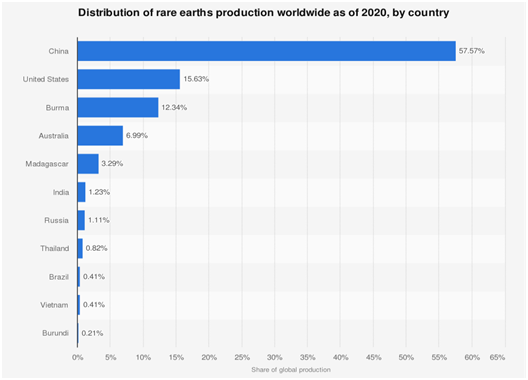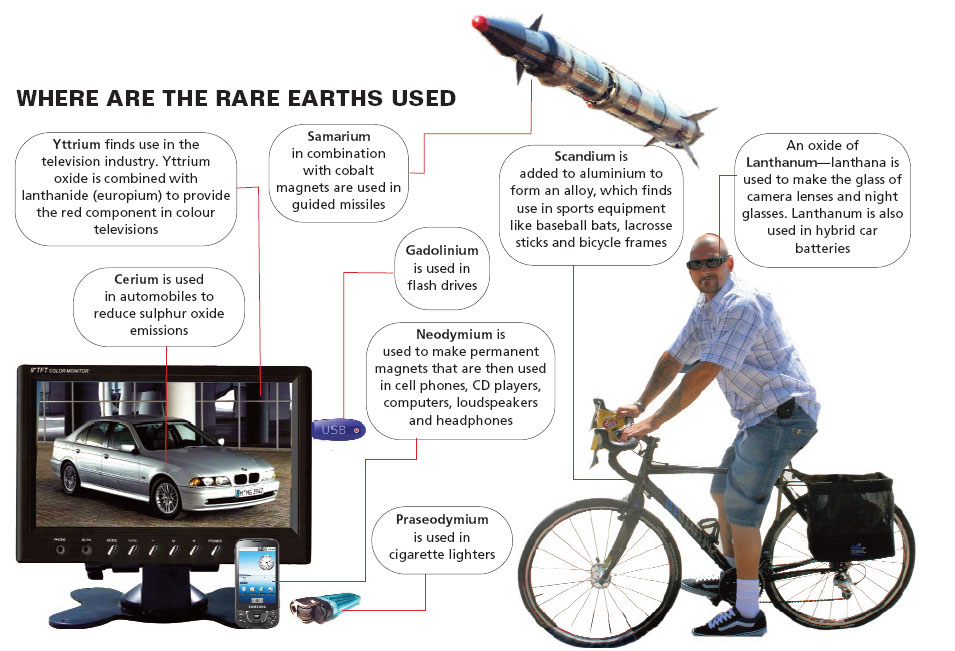Geography
Rare Earth Metals and China’s Monopoly
- 14 Jun 2021
- 6 min read
Why in News
China’s dominance in the rare earth metals, key to the future of manufacturing, is posing a major concern for the West.
Key Points
- China’s Monopoly:
- China has over time acquired global domination of rare earths, even at one point, it produced 90% of the rare earths the world needs.
- Today, however, it has come down to 60% and the remaining is produced by other countries, including the Quad (Australia, India, Japan and United States).
- Since 2010, when China curbed shipments of Rare Earths to Japan, the US, and Europe, production units have come up in Australia, and the US along with smaller units in Asia, Africa, and Latin America.
- Even so, the dominant share of processed Rare Earths lies with China.
- Heavy dependence on China (India and the World):
- India has the world’s fifth-largest reserves of rare earth elements, nearly twice as much as Australia, but it imports most of its rare earth needs in finished form from China.
- In 2019, the US imported 80% of its rare earth minerals from China while the European Union gets 98% of its supply from China.
- Opportunity for India: There are three possible approaches to maximising India’s rare earth potential.
- New Department for Rare Earths (DRE):
- India should create the new Department for Rare Earths (DRE) under the Ministry of Petroleum & Natural Gas which could secure access to Rare Earth Elements (REEs) of strategic importance by offering viability gap funding to companies to set up facilities in the upstream sector.
- This could make Indian Rare Earth Oxide (REOs) globally competitive.
- Downstream Processes and Applications:
- Alternatively, it could focus on downstream processes and applications, such as manufacturing rare earth magnets and batteries.
- This would require a focus on port infrastructure and ease of doing business measures to allow Indian manufacturers to import REOs from white-listed producers cheaply.
- Coordination with Other Agencies:
- Finally, it could coordinate with other agencies to partner directly with groupings such as the Quad, building up a strategic reserve as a buffer against global supply crises.
- With adjustments to the existing policy, India could emerge as a rare earths supplier to the world and use these resources to power a high-end manufacturing economy geared to the needs of the 21st century.
- Finally, it could coordinate with other agencies to partner directly with groupings such as the Quad, building up a strategic reserve as a buffer against global supply crises.
- New Department for Rare Earths (DRE):
Rare Earth Elements
- They are a set of seventeen metallic elements. These include the fifteen lanthanides on the periodic table in addition to scandium and yttrium that show similar physical and chemical properties to the lanthanides.
- The 17 Rare Earths are cerium (Ce), dysprosium (Dy), erbium (Er), europium (Eu), gadolinium (Gd), holmium (Ho), lanthanum (La), lutetium (Lu), neodymium (Nd), praseodymium (Pr), promethium (Pm), samarium (Sm), scandium (Sc), terbium (Tb), thulium (Tm), ytterbium (Yb), and yttrium (Y).
- These minerals have unique magnetic, luminescent, and electrochemical properties and thus are used in many modern technologies, including consumer electronics, computers and networks, communications, health care, national defense, etc.
- Even futuristic technologies need these REEs (For example high-temperature superconductivity, safe storage and transport of hydrogen for a post-hydrocarbon economy, environmental global warming and energy efficiency issues).
- They are called 'rare earth' because earlier it was difficult to extract them from their oxides forms technologically.
- They occur in many minerals but typically in low concentrations to be refined in an economical manner.
India's Current Policy on Rare Earths
- Exploration in India has been conducted by the Bureau of Mines and the Department of Atomic Energy. Mining and processing has been performed by some minor private players in the past, but is today concentrated in the hands of IREL (India) Limited (formerly Indian Rare Earths Limited), a Public Sector Undertaking under the Department of Atomic Energy.
- India has granted government corporations such as IREL a monopoly over the primary mineral that contains REEs: monazite beach sand, found in many coastal states.
- IREL produces rare earth oxides (low-cost, low-reward “upstream processes”), selling these to foreign firms that extract the metals and manufacture end products (high-cost, high-reward “downstream processes”) elsewhere.
- IREL’s focus is to provide thorium — extracted from monazite — to the Department of Atomic Energy.






